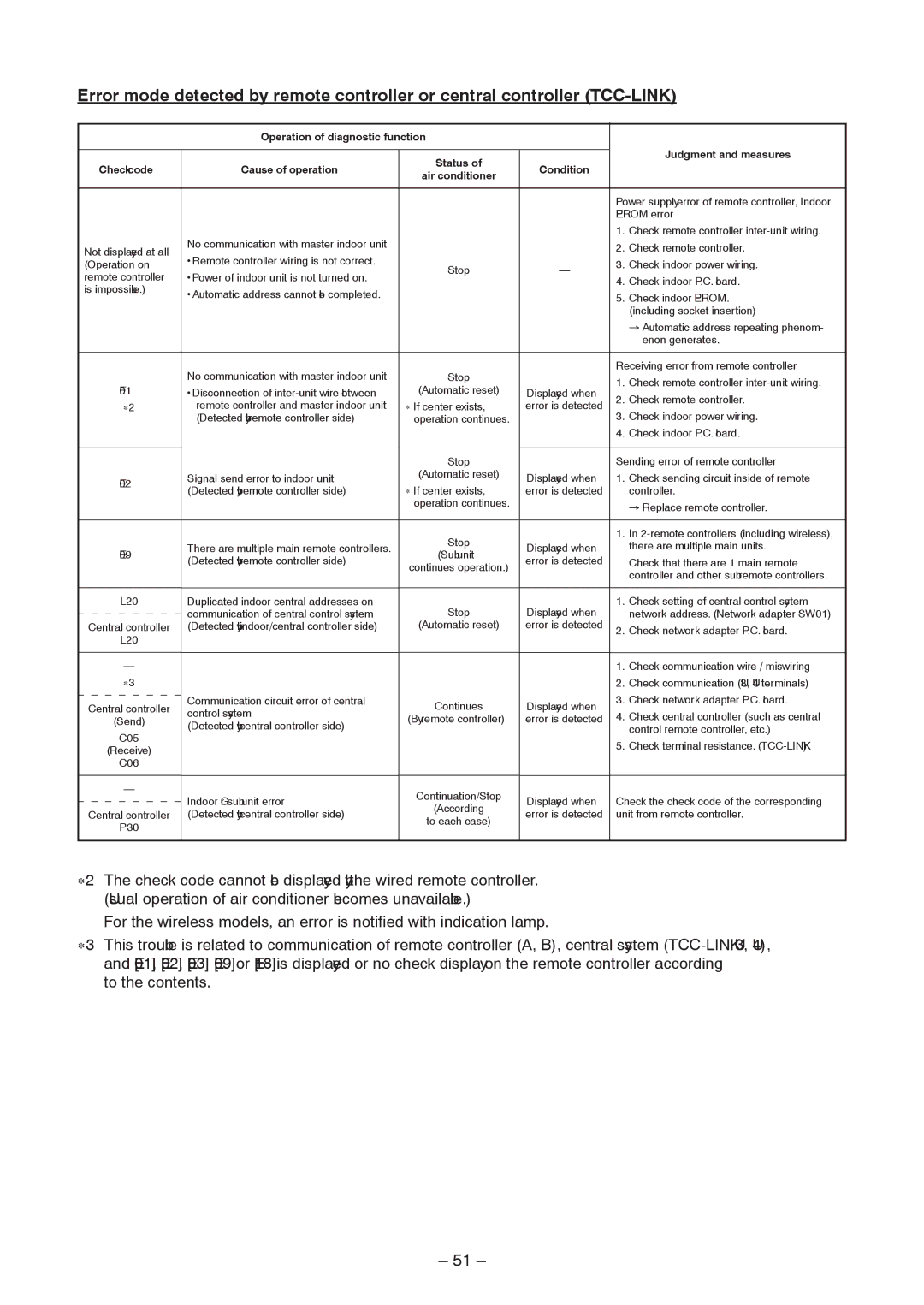Split Type
Contents
Indoort Unit
Troubleshooting
Original instruction
Indication Explanation
Explanation of indications
Explanation of illustrated marks
Work undertaken Protective gear worn
Description
Confirmation of warning label on the main unit
Precaution for Safety
Proceeding with the repair work
Refrigerant used by this air conditioner is the R410A
Resistance and water drainage
Explanations given to user
Relocation
Declaration of Conformity
Specifications
Joint
Safety Caution Concerned to New Refrigerant
Copper pipe Piping
Flare nut
General tools Conventional tools can be used
Tools
SM56 type Round duct
Concealed Duct type
SM110 type Round duct
RAV-SM404MUT∗, RAV-SM454MUT∗, RAV-SM564MUT∗
Space required for Installation and servicing
RAV-SM564BT∗, RAV-SM804BT∗, RAV-SM1104BT∗, RAV-SM1404BT∗
Dimension
RAV-SM564CT∗, RAV-SM804CT∗, RAV-SM1104CT∗, RAV-SM1404CT∗
Compact 4-way Cassette Type
RAV-SM564BT ∗, RAV-SM804BT ∗, RAV-SM1104BT ∗, RAV-SM1404BT ∗
RAV-SM564CT ∗, RAV-SM804CT ∗, RAV-SM1104CT ∗, RAV-SM1404CT ∗
Ceiling Type
Parts name Type Specifications
Specifications of Electrical Parts
Case of Connection of Wired Simple Remote Controller
Indoor Controller Block Diagram
Wireless remote controller
Case of Connection of Wireless Remote Controller
Max units
Control outline Command
Outline of specifications Remarks
Temperature in heating
Heat
Ceiling type
Outline of specifications
Conditions
Tcj
Tcn
Tc n
Setup at shipment
All operations
Cooling/dry operation Heating/fan operation
All modes
Alarm
Case of wired remote controller
LCD
Figure if To 28C
Setup AT Local
Outline of specifications Remarks
TCJ Exct Disp CHK
MCC-1402
Indoor P.C. Board Optional Connector Specifications MCC-1402
Wired remote controller type
Summary of Troubleshooting
Before troubleshooting
Troubleshooting procedure
Wireless remote controller type
Lamp indication Check code Cause of trouble occurrence
Outline of judgment
Lamp indication Check code
Others Other than Check Code
Remote controller detected
Indoor unit detected
Central control devices detected
Error mode detected by indoor unit
Check Code List
Air conditioner
Error mode detected by outdoor unit
Operation of diagnostic function Check Status
Power supply error of remote controller, Indoor
E09 error
Check code E01 error
E10 error
E04 error
E18 error
E08, L03, L07, L08 error
L09 error
L20 error
L30 error
P30 error Central controller
F10 error
P10 error
P12 error
Exchange to heating cycle
P19 error
Check by tester
Exchange to cooling cycle
F01 error
F02 error
C06 error 11 model connection interface
E03 error Master indoor unit
F29 error
P31 error Follower indoor unit
TD, TL sensor
Temperature Resistance value characteristic table
TA, TC, TCJ, TE, TS, to sensor
TA, TC, TCJ, TE,TS, to sensor
Position Resistance value
Part name Checking procedure
Case
Replacement procedures
Setting data read out from Eeprom
C. Board for indoor unit servicing replacement procedures
Code No. required at least Contents
MCC-1402
Writing the setting data to Eeprom
Type Code No
Setting data Factory-set value
Setting data Type Type name abb
Setting data Type
Compact 4-way Cassette Type and Concealed Duct Type
Test Run Setup on Remote Controller Wired remote controller
Test cooling operation Test heating operation
Procedure Description
Practical operation
LED Display on Indoor P.C. Board D002 Red
D203 Red
To change item to be set up, proceed to Procedure
Function Selection Setup
Using the set temperature
To change the selected indoor unit, proceed to Procedure
Description At shipment
Item No. DN table Selection of function
Description At shipment
Setup method
Wireless remote controller
When connected 2 remote controllers operate an idoor unit
When connected 2 remote controllers operate the twin
Contents
System example
Calling of error history Contents
Pushing Test button returns the display to usual display
Group control operation
Indoor unit power-ON sequence
Initial communication
Usual regular communication
Model name TCB-PCNT30TLE
Microprocessor block diagram
Model connection interface wiring connection
Model Connection Interface TCC-LINK adapter
C. Board Switch SW01 Setup
Wiring Specifications
Push Test + Vent buttons for 4 seconds or more
How to set up from indoor unit side by remote controller
External view of P.C. board assembly
Address setup
During unset time, At shipment from factory is displayed
Address setup procedure
Address Setup
Address Setup & Group Control Terminology
System configuration
Example
Only turning on source power supply Automatic completion
Automatic Address Example from Unset Address No miswiring
Button
Using timer time Buttons, set the line address
Push SET + CL + Test buttons
Simultaneously for 4 seconds or more
Procedure
To know the position of indoor unit body by address
Button if the unit stops
Attachment
Part name Procedure
Ceiling panel RBC-UM11PGWE Preparing work
Detachment
Part name Procedure Remarks
Panel has directionality
Part name Procedure Remarks Ceiling panel
No. Part name
Procedure Remarks
Electric parts box
No. Part name Procedure
Fan motor 1. Detachment
Drain pump 1. Detachment
Drain pan 1. Detachment
Part name Procedure Remarks Heat
Exchanger Recover refrigerant gas
Details of sensor lead wire drawing
RAV-SM∗∗∗BT ∗
Part name Procedure Remarks
Fan motor Remove the Multi blade fan
† Drain pump Remove the drain pan and float switch
100
No. Part name Procedure Remarks
101
102
103
104
209
105
Location Description Model name
404MUT-E 454MUT-E 564MUT-E
404MUT-TR 454MUT-TR 564MUT-TR
106
Location Model name
Electric parts
401
107
108
RAV-SM564BT-E RAV-SM564BT-TR
109
110
RAV-SM804BT-E RAV-SM804BT-TR
111
112
1104BT-TR
113
114
Location Model name RAV-SM Description
564BT-E 804BT-E 1104BT-E 1404BT-E
264
220
115
116
Description Model name RAV-SM
Location
117
Description 564CT-E 804CT-E 1104CT-E 1404CT-E
118
Check of Concentration Limit
Toshiba Carrier Corporation
